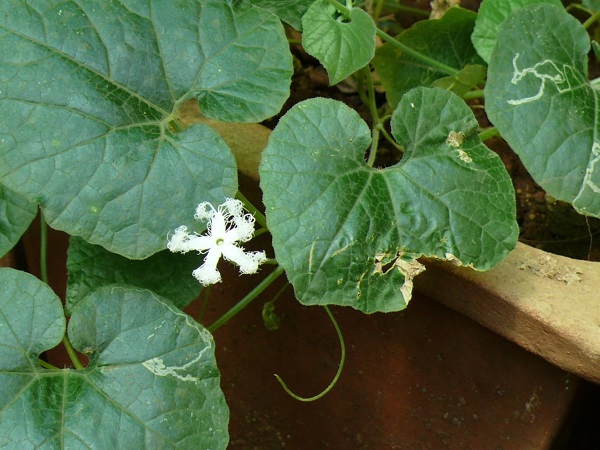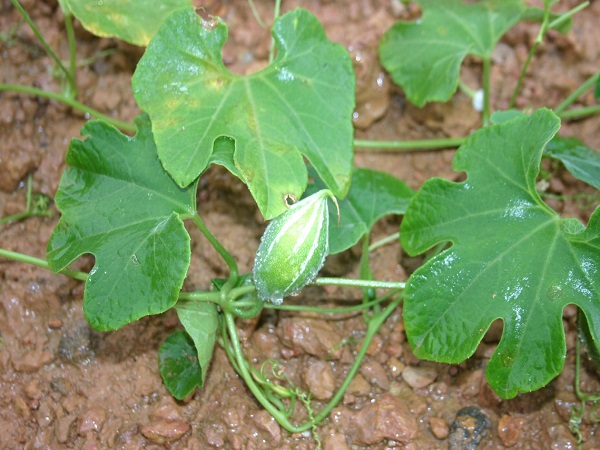
| Family | Cucurbitaceae |
| English Name | Snake gourd, Malabar patola |
| Malayalam Name | Kattupadavalam, Kaippan padavalam |
| Tamil Name | Kattupeippudal, Pudalam |
| Kannada Name | Adla balli, Kahai padavala |
| Telugu Name | Adavipotla, Chedu potla |
| Hindi Name | Caccinda, Jangli chachinda, Jangli chichonda, |
| Sanskrit Name | Amritaphala, Bijagarbha, Cicindah |
| Trade Name | Patol, Panchang |
| Part Used | Whole plant |
| In Wild | Yes |
| Under Cultivation | No |
| Temperature | 18-27 °C |
| Rainfall | NA |
| Farmers | NA |
| Traders | NA |
| Institution | NA |
| Individually | NA |
| State/Region | NA |
| District | NA |
| Nursery Information | NA |
| Yield | 100-200 kg dry vine/acre |
| Economic of cultivation | Cost of cultivation/ha: ₹ 170888 (as on 2017), Gross returns/ha: ₹ 258468 (as on 2017), Net return: ₹ 87581 (as on 2017), Benefit cost ratio: 1.5 |
| Quantitative quality standards | Foreign material: Nil, Total ash: 12.09 per cent, Acid insoluble ash: 1.98 per cent, Ethanol soluble extractive: 4.5 per cent, Water soluble extractive: 5.12 per cent, Loss on drying: 7.01 per cent (w/w) |
| Description | NA |
| Agro technology/Cultivation practices | Trichosanthes cucumerina requires a minimum temperature of 18°C during early growth, but optimal temperatures are in the range 24-27 °C. It prefers well drained sandy loam soil that is rich in organic matter. Optimum soil pH range 6-6.7, but plants tolerate alkaline soils upto pH 8.0. Planting-stock production Propagated through seeds; approximately ½ kg seeds are required for cultivating 0.4 hectare of land. Minimum 13 seeds are seen in a fruit and its average weight is 0.04 g. The size of seed, length ranges from 10 to 13.5 mm, width 5.6 to 6.60 mm, thickness 2 to 2.7 mm. Treat seeds with Trichoderma viride 4 g/kg or Pseudomonas fluorescens 10 g/kg before sowing. January- March and September- December are the ideal seasons for growing patola. For rainfed crop, sowing can commence after onset of pre-monsoon during May- June. Prepare the soil to a fine tilth by ploughing and harrowing. Beds are prepared at a distance of 5 feet (1.5 m). Pits of 60 cm diameter and 30-45cm depth are taken at a spacing of 2m x 2m. Well rotten FYM and fertilizers are mixed with topsoil in the pit. A pre- sowing irrigation 3-4 days before sowing is beneficial. Sow 4 or 5 seeds in a pit at 1-2 cm depth. Deeper sowing delays germination. Irrigate with a rose can daily. The seeds germinate in 4-5 days. Unhealthy plants are removed after two weeks and only three plants are retained per pit. In high range zone, the seedlings can be raised in greenhouses to ensure good germination and are later transplanted to the main field. Sow 2 or 3 seeds in small plastic pot filled with potting mixture. Transplant 15-20 days old seedlings into the field. In Vitro propagation Shoot tips of Trichosanthes cucumerina L. var. Cucumerina on semisolid MS basal medium supplemented with Benzyl Adenine (BA @ 1.0 mg/l) and Naphthalene Acetic Acid (NAA @ 0.1 mg/l) promoted higher number of shoot multiplication. The rate of shoot multiplication was maximum after four weeks of culture. The elongated shoots rooted within seven - eight days. The elongated shoots rooted within seven - eight days in half strength of MS basal salts supplemented 1.0 mg/l IBA and 3% (w/v) sucrose. About 90% of the rooted plantlets were acclimatized and transferred to the greenhouse and successfully transferred to the field. Manuring: Apply FYM 20-25t/ha as basal dose. Irrigation During initial stages of growth, irrigate at 3-4 days interval and in alternate days during flowering/fruiting. Furrow irrigation is the ideal method of irrigation. But in water limited environment, trickle or drip irrigation can be resorted to. During rainy season, drainage is essential for plant survival and growth. Staking and trellising Staking and trellising will increase fruit yield and size, reduce fruit rot and makes spraying and harvesting easier. Pandals are the most common trellising system used in kerala. Pandals are to be erected when the plant start vinig. Vines are supported by bamboo stakes, where vines freely climb and reach the top, which will then grow along the structure (pandal). Pruning The whole plant is used as raw drug therefore pruning is required; pruning will promote flowering and fruiting. Pest Fruit flies: Bactocera cucurbitae Fruit fly maggots feed on the internal tissues of the fruit causing premature fruit drop and yellowing and rotting of the affected fruits. Control: Bury infested fruits to prevent the build up of fruit fly population. In home gardens covering the fruits in polythene/paper covers help to prevent flies from laying eggs inside the fruits. Bait traps are effective. Snake gourd semilooper: Anadevidia peponis Caterpillar cuts the edge of leaf lamina, folds it and feed from within. Control: Hand pick the caterpillars and destroy them. 1L of Andrographis paniculata extract + 1L of cow’s urine in 10 litres of water, add 10 g of green chilli paste. Epilachna beetle: The yellowish coloured grubs and adults of the beetle feed voraciously on leaves, tender plant parts and leaves are completely skeletonized leaving only a network of veins. Control: Remove and destroy egg masses, grubs and adults occuring on leaves. Pumpkin beetle Adult beetles eat the leaves, make holes on foliage and causes damage on roots and leaves. Grubs cause damage by feeding on roots. It also feeds on flowers and bores into developing fruits that touch the soil. Control: Destroy grubs and pupae. Apply neem cake, soil drenching. Aphids: Aphis gossypi Aphids in large numbers congregate on tender parts of plant and suck sap resulting in curling and crinkling of leaves. Ants carry aphids from one plant to another. Control: Apply 1.5% fish oil soap. First dissolve soap in hot water and then make up the volume. Jassid, White flies, Aphids : Sucks sap from the lower side of the leaf. Apply Neem oil emulsion 2.5% with garlic paste(20g/l). Diseases Downy mildew: Pseudoperonospora cubensis Cottony white mycelial growth is seen on the leaf surface. Chlorotic specks can be seen on the upper surface of the leaves. It is severe during the rainy season. Control: Complete removal and destruction of the affected leaves. Spray 10% solution of neem or Andrographis paniculata preparation. Powdery mildew: Erysiphe cichoracearum The disease appears as small, round, whitish spots on leaves and stem. The spots enlarge and coalesce rapidly and white powdery mass appears on the upper leaf surface. Heavily affected leaves become yellow and later become dry and brown. Extensive premature defoliation of the older leaves resulting in yield reduction. Control: Add one part milk to two or three parts of water and apply on the diseased plant. Spraying water over the entire plant also reduces the occurrence of disease. Mosaic (Cucumber Mosaic Virus) Mosaic disease is characterized by vein clearing and chlorosis of leaves. The yellow network of veins is very conspicuous, veins and veinlets are thickened. Growths of plants infected in the early stages remain stunted and yield of the plant get severely reduced. White fly (Bemisia tabaci) is the natural vector of this virus. Control: Uprooting and destruction of affected plants and collateral hosts should be done. Apply Neem oil emulsion 2.5% with garlic paste(20g/l). |
| Harversting | Normally it takes 4 months after planting to form flowers and fruits. The young fruits are green in colour with white line running across.The matured fruits turn red when it is ripen, harvest some of them and get the seeds. The seeds are dipped in ash and stored for next year cropping. After seed collection, the entire plant is harvested. |
| Processing | The entire plant is harvested, dried in shade, bundled and sold. |
| References | NA |

